What Happenbds if You Continuously Prune Back a Vigorous Plant Vine
Pruning Ornamental Trees, Shrubs, and Vines
By David Hillock, Mike Schnelle
- Jump To:
- Reasons/Benefits
- Why Prune?
- Tools and Materials
- Care of Tools
- Wound Dressing
- When to Prune
- Spring-Flowering Trees, Shrubs, and Vines
- Summer-Flowering Trees and Shrubs
- Evergreen Trees, Shrubs, and Vines
- Broadleaf Evergreens
- Narrowleaf (Coniferous) Evergreens
- How to Prune
- Pruning Shrubs
- Pruning Hedges
- Informal Hedges
- Formal and Semiformal Hedges
- Tools for Trimming Hedges
Proper pruning enhances the beauty of almost any landscape tree and shrub and is an essential maintenance practice in home landscaping. On the other hand, improper pruning can destroy the natural beauty of a tree or shrub and reduce its landscape potential by weakening and thus disposing plants to various maladies.
Pruning, like any other skill, requires knowledge and practice to achieve success. Remember that pruning is often the removal of certain plant parts that are no longer effective or of use to the plant. It is done to redirect additional energy for the development of the flowers, fruits, foliage, and limbs that remain. Pruning essentially involves removing plant parts to improve health, landscape effect, or value of the plant. Once the objectives are determined and a few basic principles are understood, pruning is simply a matter of common sense. Pruning is not difficult if you understand the basics, and take the time to learn why, when, and how to prune.
The necessity for pruning can be reduced or eliminated by selecting the proper plant for the location. Plants that might grow too large for the site will require pruning to keep them in bounds, destroying the original intent and also making the plants unsightly and possibly weak with age. If this is the case, consider replacing the plant with a smaller growing tree or shrub such as a dwarf (shorter) or fastigiate or columnar (more narrow in width) cultivar of the original species. Unless pruning is done to form a formal hedge, espalier, or topiary, it should not be utilized to destroy or alter the plant's natural shape.
Reasons/Benefits
Pruning may be necessary to maintain a vigorous tree or shrub. Specifically, pruning is practiced to:
- Train the plant — Pruning can minimize the hazard of limbs interfering with power lines or growing over structures. It can also remove weak crotches before limbs break in strong winds or ice storms and can open blocked sight lines caused by overhanging limbs at driveways or street corners, thus preventing injury or property damage. As already alluded to, pruning and shearing can also be used to shape plants as hedges, espaliers, or topiaries.
- Maintain plant health — Removing undesirable growth can foster plant vigor through the removal of weak, overcrowded limbs. Such thinning often improves the visual balance or symmetry of the plant. Removing dead, diseased, or broken branches will also aid in maintaining the shape, vigor, and health of the plant.
- Improve the quality of flowers, fruit, foliage and stems — Removal of the current year's, faded flowers and fruit clusters may promote flower buds for the following season. Proper pruning can restore a youthful, natural growth habit in certain overgrown shrubs.
- Restrict growth — Regular pruning can prevent a plant from overgrowing its space in the landscape and eliminates the need for drastic cutting (butchery) in the future.
Why Prune?
- Maintain and improve plant health
- Improve flowering and fruiting
- Remove dead, diseased, broken wood
- Remove crossing or rubbing branches
- Control natural shape and size
- Safety
- Visibility
- Provide for sun exposure and air circulation
- Restore balance/symmetry
- Rejuvenate deciduous shrubs
Figure 1 shows all the tools the homeowner will need for proper pruning. If a power saw is needed, hire a professional arborist who is insured against personal injury and property damage. One should not climb trees with pruning tools unless experienced or when a proper safety harness is used. When climbing a ladder to reach limbs, have someone hold the ladder or tie it in place before beginning to work.
Store equipment in a dry room; keep it sharp and in good operating condition. When pruning diseased plants, disinfect all shears and saw blades after each cut to prevent spreading the disease to healthy plants. Dip the tools in rubbing alcohol or a solution consisting of one part bleach to nine parts water. An example of this is pruning fire blight from pears, pyracantha, or crabapples. At the end of the day, oil the pruning equipment well to avoid rust.
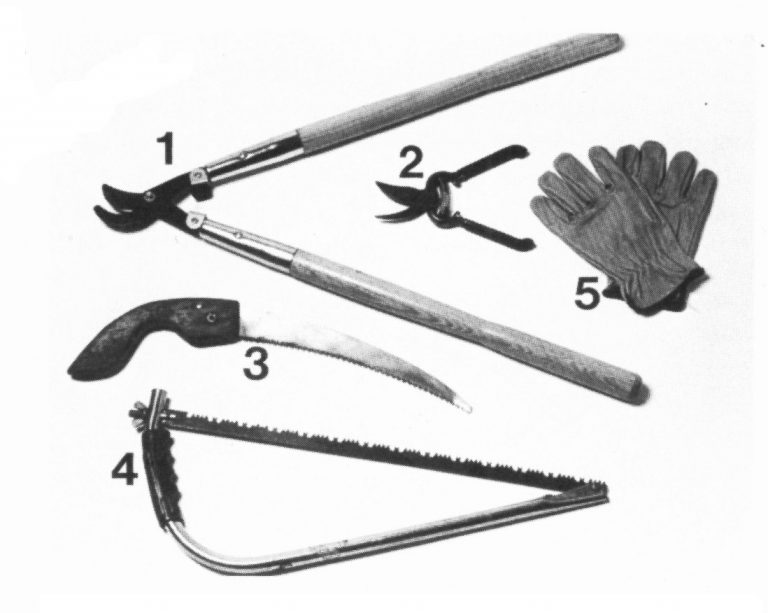
Figure 1. (1) lopping shear (2) hand pruner (3) folding saw for tight places (4) bow saw for limbs and (5) leather gloves. Note, carpenters saws gum up, pruning saws do not.
Clean and oil tools regularly, including wiping an oily cloth on blades and other metal surfaces. Keep cutting edges sharp; several passes with a good oilstone will usually suffice. Paint, varnish or otherwise preserve wooden handles. Use tools properly. Don't twist or strain pruners or loppers. Keep the branch to be cut as deeply in the jaws and near the pivot as possible. Don't cut wires with pruning tools.
Wound Dressing
Research has indicated that wound dressing or tree paint is not essential as previously thought. Dressings may actually harbor disease organisms rather than exclude them. It has also been determined that wound dressing slows the wound callusing (often incorrectly called healing) process, rather than speeding it up. A good, clean, unpainted pruning cut will normally callus faster than a painted one. On the basis of tree health alone, pruning cuts should not be painted.
When to Prune
Pruning can actually be done at any time of the year; however, recommended times vary with different plants. Contrary to popular belief, pruning at the wrong time of the year does not kill plants, but continual improper pruning results in damaged or weakened plants. Do not prune at the convenience of the pruner, but rather when it results in the least damage to the plant. There is little chance of damaging the plant if this rule is followed. In general, the best time to prune most plants is during late winter or early spring before growth begins. There are exceptions to this rule, and they will be noted under the discussion of the specific plant groups. The least desirable time is immediately after new growth develops in the spring. A great amount of carbohydrates stored in roots and stems is used in developing new growth. This "food" should be replaced by new foliage before it is removed; if not, considerable setback in plant growth may occur. This is a common problem encountered in pruning.
It also is advisable to limit the amount of pruning done late in summer as new growth may be encouraged on some plants. This "soft" growth may not have sufficient time to harden off before cold weather arrives, resulting in cold damage or winterkill. Prune plants damaged by storms or vandalism and those with dead limbs as soon as possible to avoid additional insect and disease problems that may develop.
Little pruning should be done at planting time because the young tree needs all of the stored energy (in the wood) and energy-making ability (in the leaves) it can get. Trees should not be "headed back" at planting time to "balance" the roots and crown. The tree will naturally lose branches or twigs (self-pruning) if "balance" is needed. These branches will die, at which time they can be removed. Dead, diseased, damaged, or rubbing branches, however, should be removed at planting time. Once the tree is established, it becomes important to begin pruning to ensure good form later in life.
Trees and shrubs should be examined annually for pruning requirements. Too often, pruning is ignored for several years, allowing the plants to become overgrown. Then drastic pruning is necessary to bring the plant back into form and usefulness. If trees are properly trained when young, they will need little pruning when mature. For more information on training trees, see Extension Fact Sheet HLA-6415.
Spring-Flowering Trees, Shrubs, and Vines
Exceptions to summer and fall pruning include all spring-flowering trees and shrubs. Spring-flowering trees, shrubs, and vines should be pruned as soon as the flowers have faded. Spring-flowering plants form their flowers during the summer and fall. Thus, summer, fall, or winter pruning will remove flower buds destroying the spring flowering display. Often, the flowers are the main reason for growing the plant. Plants that fall into this category include crabapple, flowering quince, forsythia, viburnum, and wisteria to name a few.
Summer-Flowering Trees and Shrubs
The blooms of summer-flowering shrubs, trees, and vines bloom on limbs produced the same season. These plants may be pruned in the fall or in early spring. Some plants in this category include glossy abelia, butterfly bush, and rose-of-Sharon.
Evergreen Trees, Shrubs, and Vines
Evergreen plants do not shed all their leaves at one time. Therefore, their branches are not bare in winter like deciduous plants. Evergreens should be pruned to control their shape and size and to remove dead, diseased, or damaged limbs. Old branches may also be removed to allow for new growth. Usually evergreens require less pruning than deciduous trees and shrubs.
Evergreens may be divided into two groups: broadleaf and narrowleaf (coniferous) evergreens.
Broadleaf Evergreens
This group includes such plants as aucuba, camellia, boxwood, cherrylaurel, elaeagnus, holly, mahonia, nandina and photinia. Pruning of most broadleaf evergreen shrubs should be done just before new growth starts in the spring. This will allow the evergreen to grow and reform itself, and pruning scars will quickly fade. Some evergreens like photinia usually have only a spring burst of growth. Leafy growth will not cover pruning done after this time until the following spring.
Many shrubs, like camellia and photinia, form well-shaped shrubs without pruning if given enough growing space.
Certain evergreens like hollies have a major burst of growth in spring and fall while others like abelia and elaeagnus grow all summer. Some broadleaf shrubs such as hollies can be cut back to a stump and regrow. Others like photinia and boxwood may die or recover very slowly if pruned severely.
Southern magnolia is common in Oklahoma. It is a broadleaf evergreen tree that responds poorly to heavy pruning. Do not remove the lower limbs when a magnolia is young, or the bark may sunscald.
Narrowleaf (Coniferous) Evergreens
With few exceptions, narrowleaf evergreens have few or no dormant buds on the older barren parts of the trunk or limbs. Therefore, timing and degree of pruning must be carefully considered. Cutting all the green leaves (needles) off coniferous evergreens will kill the plants.
The narrowleaf evergreens can be divided into two general classes: needle-leaf and scale-leaf. The proper time and methods of pruning depend on which of the classes the evergreen belongs.
The pine tree is a good example of a needle-leaf evergreen. Trees and shrubs in this class bear branches that radiate from the trunk in whorls, like spokes from a hub. There is a length of bare trunk between the whorls. Pine, fir, spruce and true cedar (Cedrus) belong to this class.
New growth on pine trees looks like tan candles on the ends of limbs in the spring. Pruning time should be limited to while the candle is tan-colored and before the needles reach full length. Portions of a needle-leafed evergreen tree or shrub may be sheared at this stage of growth to thicken an open spot in the foliage. Always leave one-half the length of the candle or new growth when shearing or pruning (Figure 2).
Shearing this class of plants after the candle or new growth stage, or below the candle, may result in death or disfigurement because new terminal buds may not be formed. Do not remove the top leader of this group unless you want the plant to be shorter and denser. Some evergreens such as spruce and fir often fail to produce a new leader resulting in a broad, awkward shape not typical of the species.
Arborvitae and junipers are good examples of the scale-leaf class of coniferous evergreens, which bear their branches irregularly, somewhat like deciduous plants. Other examples include cypress, false-cypress, China fir, incense-cedar, and yew. This class can be pruned just before new growth begins in the spring and again in May, June, or July to shape or control growth. This allows new growth to cover scars before the dormant season. Just cut back to a branch fork with a green shoot. Work from underside of branches and slant the cuts upward. Make some cuts several inches deeper into the foliage mass than others to ensure a natural looking plant.
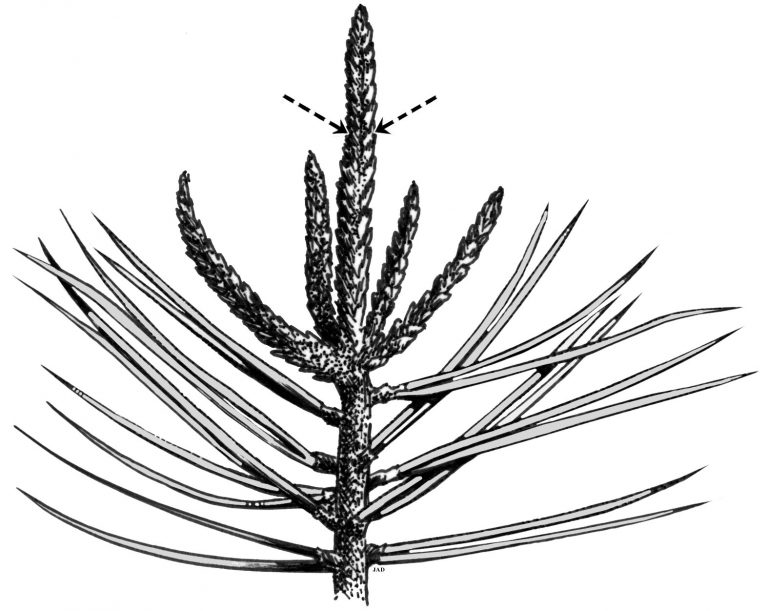
Figure 2. Always leave one-half the length of the candle or new growth when shearing or pruning.
How to Prune
First, never remove more than one-third of the branching system of any tree or about two-thirds of a shrub or vine in any year. There are exceptions however, with some shrubs able to regenerate themselves from the root system. Dehorning or topping of a tree is never warranted! Dehorning a tree (Figure 3) substantially shortens its life because the stubs that are left cannot callus over and usually become infected with heartwood rot and borers. Regrowth after dehorning forms many narrow "V" crotches, which are subject to splitting during storms. Dehorning places such tremendous stress on a tree that most trees die prematurely as a result.
Pruning should follow a definite plan. Consider the reason or purpose before cutting begins. By making the pruning cuts in a certain order, the total number of cuts is reduced greatly. Begin by removing all dead, broken, diseased, or problem limbs by cutting them at the point of origin or back to a strong lateral branch or shoot. Removing this material often opens the canopy sufficiently that no further pruning is necessary.
The next step in pruning is to make any training cuts needed. By cutting back lateral branches, the tree or shrub is trained to develop a desired shape, to fill in an open area caused by storm or wind damage, or to keep it in bounds to fit a given area. To properly train a plant, always prune in observance of its natural shape or growth habit.
Employ additional corrective prunings to eliminate weak or narrow crotches and remove the less desirable central leader where double leaders occur. After these cuts have been made, stand back and take a look at your work. Are there any other corrective pruning cuts necessary? If the amount of wood removed is considerable, further pruning may need to be delayed a year or so. Remove water sprouts (fast-growing shoots often perpendicular to stem) unless needed to fill a hole or to shade a large limb until other branches develop.
A properly pruned tree is never obvious. If it becomes necessary to remove a large limb, do so as illustrated in Figure 4. If you do not follow these three steps, often even on smaller limbs, the weight of the limb will split the limb at the halfway point and rip or peel the bark, leaving a gaping wound. Pruning wounds should be kept as small as possible. Study the way the tree or shrub branches grow naturally. Some plants have opposite branches, some alternate, and some that whorl around the limb where they attach to the trunk.
Do not cut flush to the trunk, even in the absence of branch collars. Instead, remove limbs with bulges (branch collar) flush to the bulge, not flush with the trunk. Remove limbs without the swelling almost flush with the trunk.
Both types of limbs can occur on the same tree, and some trees have no swelling. Some have very narrow acute-angled branching. Others have open or L-shaped branching. The wider the angle to 90°, the stronger the branch union may be with the trunk. Branches with less than a 30° angle of attachment often should be removed or cabled. Otherwise, strong winds may split the limb away from the trunk. Still, there are exceptions to this rule. Some trees such as zelkova (Zelkova spp.) typically have very narrow branch angles. It therefore is important to know the typical growth habit of the species in question.
"Prune to the outside" is a typical statement on pruning publications. This means prune so the shoots after growth will grow away from the center of the plant. Be sure to study the position of buds on the limbs before you prune.
Buds become flowers, leaves, or twigs. Larger buds tend to be floral. Bud position determines the angle of the limb or twig and its direction of growth.
Therefore, either remove the limbs growing toward the center of the plant or cut back to a larger bud pointing outward from the stem, toward the outside of the tree or shrub.
Regardless of what you are going to prune, start at the tip of the branches and trace downward toward the trunk or base. Growth can be diverted to smaller twigs, branches, or buds which will change the direction of growth. Usually, more than one bud is stimulated to grow behind a pruning cut. The larger bud or branch will generally become dominant and determine the shape of the plant. So cut back to vigorous shoots or buds facing or growing in the desired direction. This process is often referred to as cutting back to a lateral (branch or twig).
Splits in the main trunk of a tree require special attention and care by a trained arborist. Because of the special equipment and care needed, it is best to leave this kind of repair to a professional arborist. Incidentally, properly trained trees seldom need cabling or bracing at maturity.
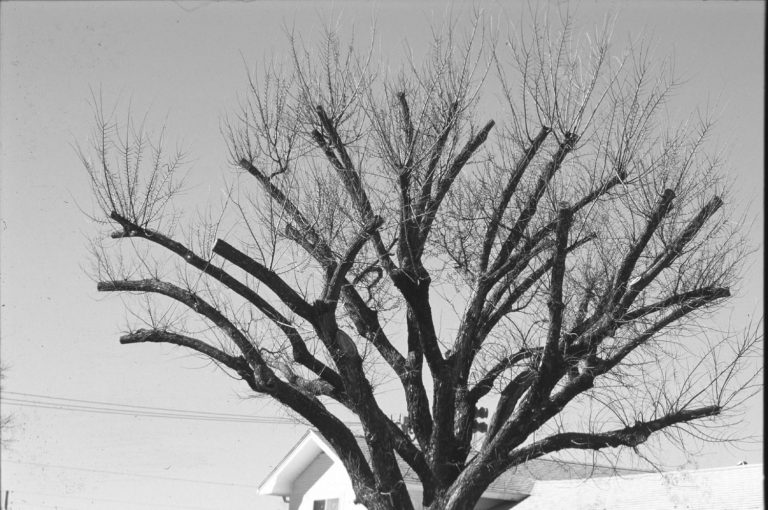
Figure 3. Dehorning or topping of a tree.
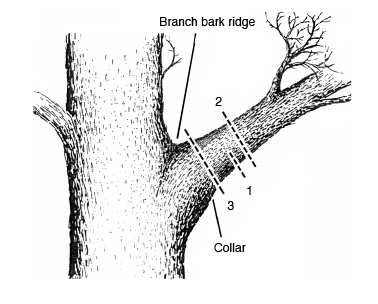
Figure 4. The three-cut method for removing heavy limbs.
Pruning Shrubs
Most shrubs do better if pruned a little every year rather than waiting until major pruning is necessary. Drastic pruning ruins the appearance and flowering or fruiting ability of some plants for several years. It is best to cut off a portion up to one-third of the old stems at ground level and then remove a portion (one-third to one-half) of the remaining top growth. Dense twigs and leaves make insect and disease control more difficult. Less annual pruning is generally required for evergreen shrubs than deciduous shrubs.
Pruning recommendations for most deciduous shrubs consist of thinning out, gradual renewal, and rejuvenation pruning. In thinning out, a branch or twig is cut off at its point of origin from either the parent stem or ground level (Figure 5). This pruning method results in a more open plant; it does not stimulate excessive new growth, but it does allow room for growth of side branches. Considerable growth can be cut off without changing the plant's natural appearance or growth habit. Plants can be maintained at a given height and width for years by thinning out. This method is best done with hand pruning shears, loppers, or a saw, but not with hedge shears. Thin out the oldest and tallest stems first.
In gradual renewal pruning, a few of the oldest and tallest branches are removed at or slightly above ground level on an annual basis (Figure 6). Some thinning may be necessary to shorten long branches or maintain a symmetrical shape. To rejuvenate an old, overgrown shrub, remove one-third of the oldest, tallest branches at or slightly above ground level before new growth starts. When old shrubs have not been properly pruned, most of the top growth often comes from two or three old stems. This makes it difficult to cut the old stems clear to the ground without cutting off all the new growth. When this is the case, make cuts far enough above ground to leave some new growth.
New bare-root shrubs, such as those purchased with their roots in paper or plastic bags, should not be pruned at planting. Container-grown or balled and burlapped shrubs require little pruning as well at planting.
Evergreen shrubs are pruned like deciduous shrubs to control and shape their natural form. But less pruning is required since they are slower growing and provide a year-round effect. Long seasonal shoots growing above the main shrub body may be cut back or removed entirely at any time. Narrow-leaf evergreen shrubs like junipers should be pruned to maintain their graceful form and not sheared (Figure 7).
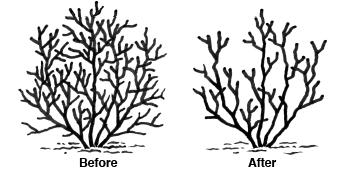
Figure 5. Proper thinning of a shrub.
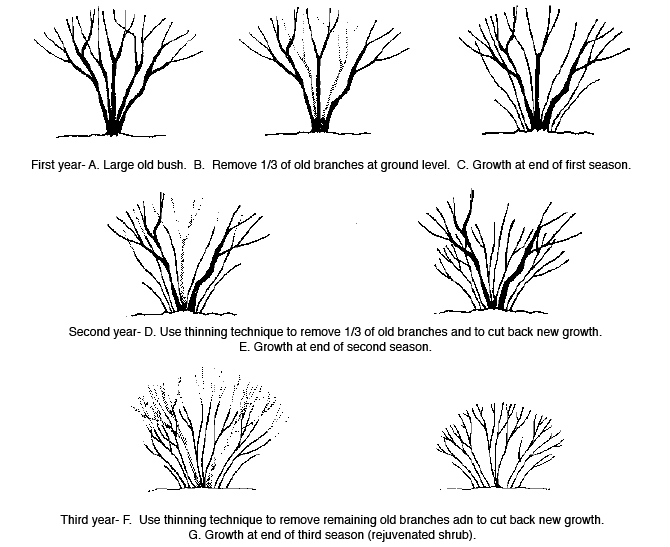
Figure 6. Renewal pruning.
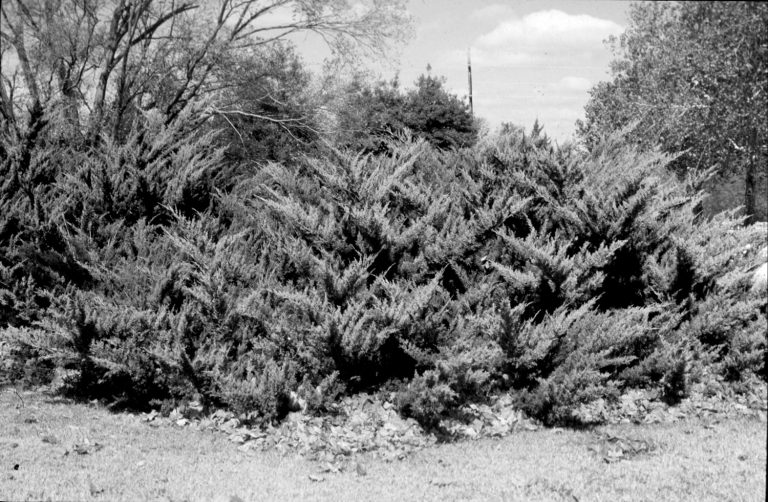
Figure 7. Proper growth of Junipers.
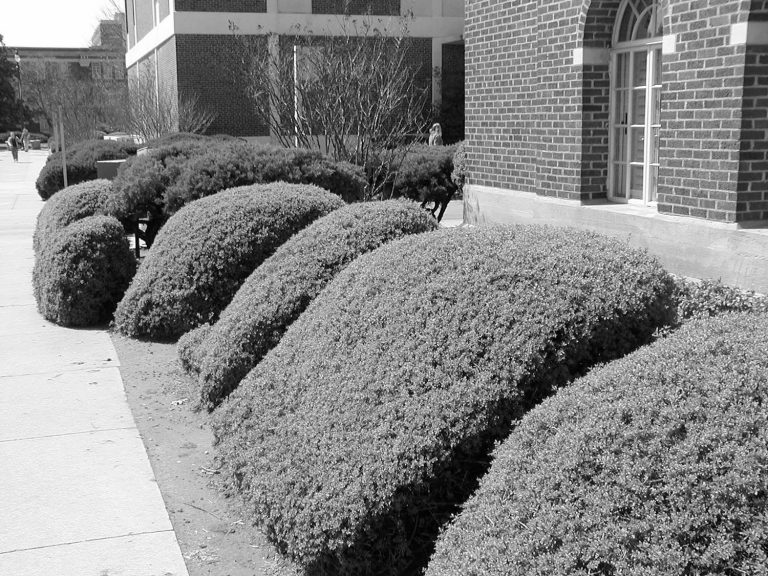
Improperly sheared junipers.
Pruning Hedges
Hedges are a row of plants that merge into a solid linear mass. They have served gardeners for centuries as screens, fences, walls, and edging.
A well-shaped hedge is no accident. It must be trained from the beginning. Establishing a deciduous hedge begins with selection of nursery stock. Choose young shrubs one to two feet high, preferably multiple-stemmed.
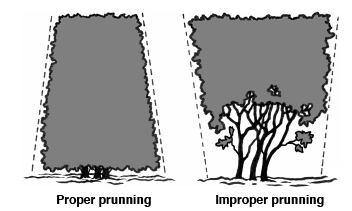
Figure 8. Proper prunning and improper prunning of a shrub.
Informal Hedges
Spacing of plants for informal hedges should allow branches to extend into each other when mature. This is done by placing them together at a distance slightly less than the mature width. For example, a plant that has a mature spread of 6 feet would be 4 feet apart, and one with a 10-foot spread, about 8 feet.
Do not trim back shrubs at planting like a formal hedge, rather hand prune individual branch tips to encourage a full, bushy growth and maintain the natural form of the plants.
Formal and Semiformal Hedges
Space plants closer together than if they were growing in informal groupings, usually 1 to 3 feet apart for larger types or as close at 6 inches for small dwarf types. The exact spacing will depend on the overall width of the hedge (plant spread) and how fast you want the hedge to be full.
When planting, cut larger plants by about a third and smaller ones to about six or eight inches; this induces low branching. Late in the first season or before bud-break in the next season, prune off half of the new growth. The following year, again trim off half.
In the third year, start shaping. Trim to the desired shape before the hedge grows to its desired size. Never allow plants to grow untrimmed to the final height before shearing; by that time, it is too late to get maximum branching at the base. Do not allow lower branches to be shaded out. After the hedge has reached the desired dimensions, trim closely in order to keep the hedge within chosen bounds.
Evergreen nursery stock for hedging need not be as small as deciduous material and should not be cut back when planted. Trim lightly after a year or two. Start shaping as the individual plants merge into a continuous hedge. Do not trim too closely because many needle-bearing evergreens do not easily generate new growth from old wood.
Hedges are often shaped with flat tops and vertical sides; however, this unnatural shape is seldom successful. As far as the plant is concerned, the best shape is a natural form, with a rounded or slightly pointed top, with the sides slightly tapering to form a wide base (Figure 8).
After plants have been initially pruned to include low branching, maintain by trimming the top narrower than the bottom so that sunlight can reach all of the plant leaves.
These questions often arise: How often should a hedge be trimmed? When should it be trimmed? Answers to these common questions depend to some extent on how formal an appearance is desired. In general, trim before the new growth exceeds one foot.
Hedges of slow-growing plants such as boxwood need to be trimmed sooner. Excessive untrimmed growth will kill lower leaves and will also pull the hedge out of shape. Trimming frequency depends on the kind of shrub, the season, and desired formal appearance.
What can be done with a large, overgrown, bare-bottomed and misshapen hedge? If it is deciduous, the answer is fairly simple. In spring before leaves appear, prune to one foot below desired height. Then carefully trim for the next few years to give it the desired shape and fullness. Occasionally, hedge plants may have declined too much to recover from this treatment, making it necessary to replace them.
Rejuvenating evergreen hedges is more difficult. As a rule, evergreens cannot tolerate the severe pruning described above. Arborvitae and yew may be exceptions under certain circumstances. Other evergreen hedges may have to be replaced.
What tools should be used to trim hedges? The traditional pair of scissor-action hedge shears is still the best all-around tool. It cuts much better and closer than electric trimmers, which often break and tear twigs. Hand shears can be used on any type of hedge, while electric trimmers do poorly on large-leafed and wiry-twigged varieties, sometimes jamming on thick twigs. Hand shears are also quieter, safer, and less likely to gouge the hedge or harm the operator.
Hand pruners are useful in removing a few stray branches and are essential if an informal look is desired. Large, individual branches can be removed with loppers or a pruning saw. Chain saws are not recommended for use on hedges.
David Hillock
Extension Consumer Horticulturist
Mike Schnelle
Extension Ornamentals–Floriculture Specialist
Was this information helpful?
YESNO
Source: https://extension.okstate.edu/fact-sheets/pruning-ornamental-trees-shrubs-and-vines-2.html
0 Response to "What Happenbds if You Continuously Prune Back a Vigorous Plant Vine"
Post a Comment